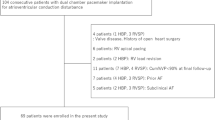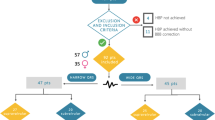Abstract
Background
Atrial electromechanical delay (AEMD) is an echocardiographic parameter correlated with the onset of supraventricular arrhythmias in several clinical conditions. Inter-atrial septal pacing in the region of Bachmann’s bundle (BB) has been shown to be safe and feasible in myotonic dystrophy type 1 (DM1) patients, with a low rate of sensing and pacing defects. The aim of this study was to assess the impact of temporary BB pacing compared with right atrial appendage (RAA) pacing on AEMD in DM1 patients undergoing pacemaker (PM) implantation for cardiac rhythm abnormalities.
Methods
The study enrolled 70 consecutive DM1 patients undergoing PM implantation for cardiac rhythm abnormalities in accordance with the current guidelines. Seventy age- and sex-matched non-DM1 patients undergoing dual-chamber PM implantation for cardiac rhythm abnormalities were used as controls. The atrial pacing lead was temporarily positioned in the RAA and on the right side of the inter-atrial septum in the region of Bachmann’s bundle. For each site (BB and RAA), temporary atrial pacing in the AAI mode was established at 10 beats per minute above the sinus rate and a detailed trans-thoracic echocardiogram with tissue Doppler (TDI) analysis was recorded after at least 10 min of atrial pacing to evaluate AEMD.
Results
Temporary RAA pacing did not show statistically significant differences in inter-AEMD (48.2 ± 17.8 vs 50.5 ± 16.5 ms; P = 0.8), intra-left AEMD (43.3 ± 15.5 vs 44.6 ± 15.8 ms; P = 0.1), or intra-right-AEMD (14.1 ± 4.2 vs 15.4 ± 5.8 ms; P = 0.9), in comparison with sinus rhythm. Temporary BB pacing determined a significantly lower inter-AEMD (36.1 ± 17.1 vs 50.5 ± 16.5 ms; P = 0.001) and intra-left AEMD (32.5 ± 15.2 vs 44.6 ± 15.8 ms; P = 0.001) values in comparison with temporary RAA pacing. No statistically significant difference was found in intra-right AEMD (12.2 ± 4.6 vs 15.4 ± 5.8 ms; P = 0.2). In the control group, neither temporary RAA pacing nor temporary BB pacing showed statistically significant differences in inter-AEMD, intra-left AEMD, or intra-right AEMD values in comparison with sinus rhythm.
Conclusions
In DM1 patients undergoing dual-chamber PM implantation, atrial pacing in the Bachmann bundle region is associated with significantly lower echocardiographic indices of atrial electromechanical delay (inter-AEMD and intra-left AEMD) in comparison with RAA pacing.




Similar content being viewed by others
References
Pelargonio G, Dello Russo A, Sanna T, et al. Myotonic dystrophy and the heart. Heart. 2002;88:665–70.
Groh WJ, Groh MR, Chandan S, et al. Electrocardiographic abnormalities and sudden death in myotonic dystrophy type 1. N Engl J Med. 2008;358:2688–97.
Laurent V, Pellieux S, Corcia P, Magro P, Pierre B, Fauchier L, et al. Mortality in myotonic dystrophy patients in the area of prophylactic pacing devices. Int J Cardiol. 2011;150:54–8.
Russo V, Di Meo F, Rago A, Papa AA, Molino A, Mosella M, et al. Paroxysmal atrial fibrillation in myotonic dystrophy type 1 patients: P wave duration and dispersion analysis. Eur Rev Med Pharmacol Sci. 2015;19:1241–8.
Russo V, Papa AA, Rago A, Nigro G. Which is the true epidemiology of atrial fibrillation in myotonic dystrophy type 1 patients? Pacing Clin Electrophysiol. 2016 Dec;39(12):1418–9.
Russo V, Nigro G, Rago A, Antonio Papa A, Proietti R, Della Cioppa N, et al. Atrial fibrillation burden in myotonic dystrophy type 1 patients implanted with dual chamber pacemaker: the efficacy of the overdrive atrial algorithm at 2 year follow-up. Acta Myol. 2013;32:142–7.
Russo V, Rago A, Papa AA, Politano L, Golino P, Russo MG, et al. Does a high percentage of right ventricular pacing influence the incidence of paroxysmal atrial fibrillation in myotonic dystrophy type 1 patients? Kardiol Pol. 2013;71:1147–53.
Russo V, Nigro G, Papa AA, Rago A, Della Cioppa N, Cristiano A, et al. Adenosine-induced sinus tachycardia in a patient with myotonic dystrophy type 1. Acta Myol. 2014;33:104–6.
Brembilla-Perrot B, Schwartz J, Huttin O, Frikha Z, Sellal JM, Sadoul N, et al. Atrial flutter or fibrillation is the most frequent and life-threatening arrhythmia in myotonic dystrophy. Pacing Clin Electrophysiol. 2014 Mar;37(3):329–35.
Russo V, Rago A, Nigro G. Sudden cardiac death in neuromuscolar disorders: time to establish shared protocols for cardiac pacing. Int J Cardiol. 2016 Mar 15;207:284–5.
Nigro G, Russo V, Vergara P, D’Andrea A, Di Gregorio G, Politano L, et al. Optimal site for atrial lead implantation in myotonic dystrophy patients: the role of Bachmann’s bundle stimulation. Pacing Clin Electrophysiol. 2008;31:1463–6.
Nigro G, Russo V, Politano L, Della Cioppa N, Manfredi D, Chianese R, et al. Right atrial appendage versus Bachmann’s bundle stimulation: a two-year comparative study of electrical parameters in myotonic dystrophy type-1 patients. Pacing Clin Electrophysiol. 2009;32:1191–6.
Antoni ML, Bertini M, Atary JZ, Delgado V, ten Brinke EA, Boersma E, et al. Predictive value of total atrial conduction time estimated with tissue Doppler imaging for the development of new-onset atrial fibrillation after acute myocardial infarction. Am J Cardiol. 2010;106:198–203.
Ari H, Ari S, Akkaya M, Aydin C, Emlek N, Sarigül OY, et al. Predictive value of atrial electromechanical delay for atrial fibrillation recurrence. Cardiol J. 2013;20(6):639–47.
Calik AN, Ozcan KS, Cağdaş M, Güngör B, Karaca G, Gürkan U, et al. Electromechanical delay detected by tissue Doppler echocardiography is associated with the frequency of attacks in patients with lone atrial fibrillation. Cardiol J. 2014;21(2):138–43.
Russo V, Rago A, Di Meo F, Papa AA, Ciardiello C, Cristiano A, et al. Atrial septal aneurysms and supraventricular arrhythmias: the role of atrial electromechanical delay. Echocardiography. 2015;32:1504–14.
Rago A, Russo V, Papa AA, Ciardiello C, Pannone B, Mayer MC, et al. The role of the atrial electromechanical delay in predicting atrial fibrillation in beta-thalassemia major patients. J Interv Card Electrophysiol. 2017 Mar;48(2):147–57.
Russo V, Di Meo F, Rago A, Mosella M, Molino A, Russo MG, et al. Impact of continuous positive airway pressure therapy on atrial electromechanical delay in obesity-hypoventilation syndrome patients. J Cardiovasc Electrophysiol. 2016 Mar;27(3):327–34.
Brignole M, Auricchio A, Baron-Esquivias G, Bordachar P, Boriani G, Breithardt OA, et al. 2013 ESC Guidelines on cardiac pacing and cardiac resynchronization therapy: the Task Force on cardiac pacing and resynchronization therapy of the European Society of Cardiology (ESC). Developed in collaboration with the European Heart Rhythm Association (EHRA). Eur Heart J. 2013 Aug;34(29):2281–329.
Deniz A, Sahiner L, Aytemir K, Kaya B, Kabakci G, Tokgozoglu L, et al. Tissue Doppler echocardiography can be a useful technique to evaluate atrial conduction time. Cardiol J. 2012;19:487–93.
Russo V, Nigro G, Antonio Papa A, Rago A, Di Meo F, Cristiano A, et al. Far field R-wave sensing in myotonic dystrophy type 1: right atrial appendage versus Bachmann’s bundle region lead placement. Acta Myol. 2014;33:94–9.
Bailin SJ, Adler S, Giudici M. Prevention of chronic atrial fibrillation by pacing in the region of Bachmann’s bundle: results of a multicenter randomized trial. J Cardiovasc Electrophysiol. 2001;12:912–7.
Yu WC, Tsai CF, Hsieh MH, Chen CC, Tai CT, Ding YA, et al. Prevention of the initiation of atrial fibrillation: mechanism and efficacy of different atrial pacing modes. Pacing Clin Electrophysiol. 2000;23:373–9.
Padeletti L, Pürerfellner H, Adler SW, Waller TJ, Harvey M, Horvitz L, et al. Combined efficacy of atrial septal lead placement and atrial pacing algorithms for prevention of paroxysmal atrial tachyarrhythmia. J Cardiovasc Electrophysiol. 2003;14:1189–95.
Hakacova N, Velimirovic D, Margitfalvi P, Hatala R, Buckingham TA. Septal atrial pacing for the prevention of atrial fibrillation. Europace. 2007;9:1124–8.
Katsivas A, Manolis AG, Lazaris E, Vassilopoulos C, Louvros N. Atrial septal pacing to synchronize atrial depolarization in patients with delayed interatrial conduction. Pacing Clin Electrophysiol. 1998;21:2220–5.
Russo V, Rago A, Ciardiello C, Russo MG, Calabrò P, Politano L, et al. The role of the atrial electromechanical delay in predicting atrial fibrillation in myotonic dystrophy type 1 patients. J Cardiovasc Electrophysiol. 2016 Jan;27(1):65–72.
Author information
Authors and Affiliations
Ethics declarations
Conflict of interest
The authors declare that they have no conflict of interest.
Research involving human participants
All procedures performed in studies involving human participants were carried out in accordance with the ethical standards of the institutional and/or national research committee and with the 1964 Helsinki Declaration and its later amendments or comparable ethical standards.
Informed consent
Informed consent was obtained from all individual participants included in the study.
Rights and permissions
About this article
Cite this article
Russo, V., Rago, A., Papa, A.A. et al. Bachmann bundle pacing reduces atrial electromechanical delay in type 1 myotonic dystrophy patients. J Interv Card Electrophysiol 51, 229–236 (2018). https://doi.org/10.1007/s10840-018-0331-5
Received:
Accepted:
Published:
Issue Date:
DOI: https://doi.org/10.1007/s10840-018-0331-5




